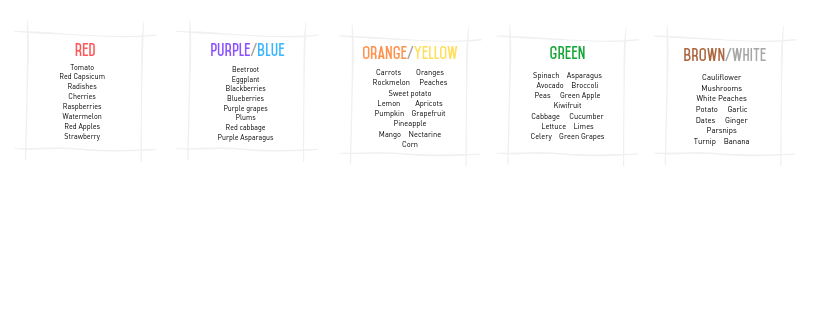Originally developed as a way to get fussy kids to eat more fruit and vegetables, this idea of “eating the rainbow” is now being used by people of all ages to ensure they are meeting their daily fruit and veg needs. Eating the colours of the rainbow does not mean filling up your trolley with a range of those colourful processed options that catch your eye on the shelf. It’s about sticking to those outer aisles of the supermarket and choosing a variety of fruits and vegetables that are going to fill your body with the nutrients it needs! Fruits and vegetables come in all different beautiful colours that are caused by specific phytonutrients which are natural chemicals that help protect plants from bugs, germs, the sun’s harmful rays and other threats. Not only will your plate look pretty but each colour indicates an abundance of unique nutritional benefits.
RED
Red fruits and vegetables are coloured by a natural plant pigment called lycopene. Lycopene is a powerful antioxidant that has been found to reduce the risk of cancer and keep our heart healthy by protecting our cells from damage.
Tip: Cook your tomatoes! The body absorbs lycopene better when it’s been cooked.
PURPLE/BLUE
Fruits and vegetables with this distinct colour get their pigment from anthocyanin, which also has antioxidants properties that protect cells from damage and can help reduce the risk of cancer, stroke and heart disease.
Tip: Take a trip to the dark side! Did you know the darker the fruit of veg, the more antioxidants it has? So dig in to those berries, plums, and purple grapes.
ORANGE/YELLOW
The plant pigment carotenoids give this group their vibrant colour. Probably the most well-known carotenoid is the betacarotene which is found in sweet potatoes, pumpkins and carrots, which the body converts to Vitamin A, helping maintain healthy mucous membranes and healthy eyes! It also helps protect the skin against the sun and improves immune function. Another common carotenoid is lutein, which is stored within the eye and has been found to prevent age-related degeneration within our eyes.
Tip: The body converts as much Vitamin A from beta-carotene as it needs, so it is recommended you get your Vitamin A from foods instead of supplements. Carotenoids are also best absorbed by the body with some fats, so be sure to cook up your yellow or orange veg with a little oil.
GREEN
Green fruits and vegetables contain a variety of phytochemicals including indoles, saponins and carotenoids, all of which have anti-cancer properties and are also good for eye health. The also help aid tissue healing, restore energy and boosts immune system. Dark leafy green options such as kale, spinach and broccoli all supply excellent sources of folate.
Tip: Are green veg the hardest to get the kids to eat? Try throwing some spinach or kale into their morning smoothie, turn them into oven baked chips or toss some cabbage, broccoli or asian greens through a stew!
BROWN/WHITE
White fruits and vegetables contain a bunch of health-promoting phytochemicals such as allicin which is known for its antiviral and antibacterial properties. Some members of the white group are also great sources of potassium such as bananas and potatoes which are important for heart and muscle function. The fibre found in foods such as pears and potatoes are great for a healthy digestive tract, along with mushrooms that contain selenium, which plays a key role in metabolism.
Tip: Embrace your garlic breath! Garlic is packed with allicin!


 view our boxes here
view our boxes here

